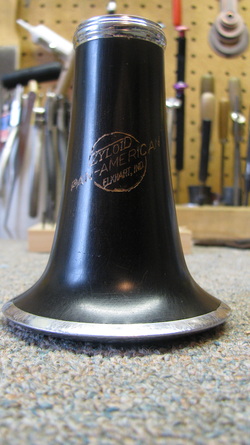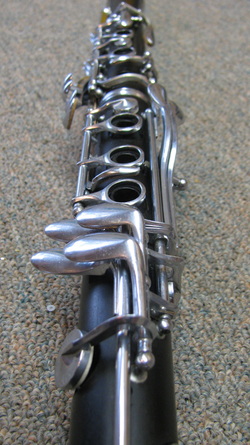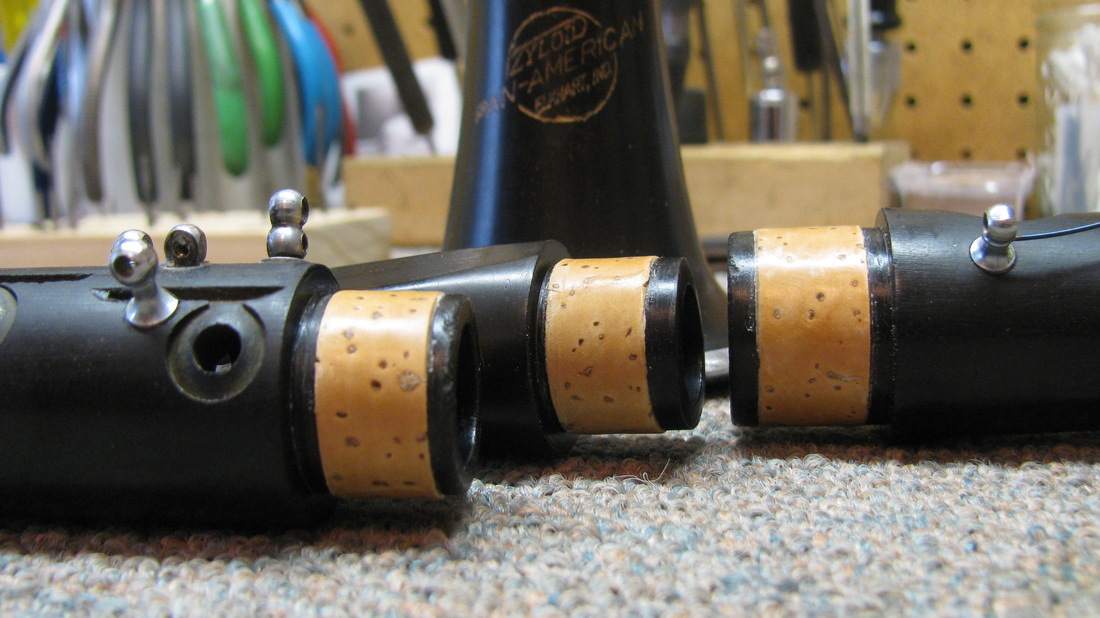 Pan-American Zyloid trademark: Re-gilded.
Pan-American Zyloid trademark: Re-gilded. I recently restored a Pan-American Zyloid soprano clarinet. For those who do not know, that means this clarinet was made around 1965 by C.G.Conn. Conn is one of the oldest manufacturers of band instruments in America, and was a leading producer of both student and professional level instruments. Pan-American was a name Conn used for their student line, and Zyloid refers to the space-aged plastic Conn was using at the time; it was the 60's after all, think Seattle Worlds Fair.
Restoring this clarinet provided a good opportunity to explain, and illustrate with pictures, the advantages to investing in old and neglected instruments.
A lot of people will say, "Wait a minute, this junky clarinet is fifty years old and has been sitting around collecting dust. Is it even worth it? Shouldn't I buy a good new one? I found one on line selling brand new for $130? In fact there are several advantages to investing in an old instrument.
Let's start with the financial advantages. The manufacturing world is not what it was fifty years ago. There is a huge demand for cheap goods, and a seemingly endless pool of cheap labor. As the market demands even cheaper goods, the manufacturers find an even cheaper labor pool elsewhere. And the pressure to make bigger profits leads manufacturers to find less expensive materials and reduce labor costs. That means using materials of lesser quality, and cutting corners in manufacturing. Or pressuring workers to produce more, in less time, while reducing the work force even further to decrease labor costs.
There is a deluge of instruments made in this fashion. They do end up in the hands of kids who otherwise might not afford one, providing them the opportunity to learn music. But these instruments often come with bent keys, due to soft alloys, intonation problems, poorly made mouthpieces that blow hard, and any number of other manufacturing defects. Some repair shops are not willing to work on these instruments and when they do, the cost of the repair quickly exceeds that of the instrument.
Restoring this clarinet provided a good opportunity to explain, and illustrate with pictures, the advantages to investing in old and neglected instruments.
A lot of people will say, "Wait a minute, this junky clarinet is fifty years old and has been sitting around collecting dust. Is it even worth it? Shouldn't I buy a good new one? I found one on line selling brand new for $130? In fact there are several advantages to investing in an old instrument.
Let's start with the financial advantages. The manufacturing world is not what it was fifty years ago. There is a huge demand for cheap goods, and a seemingly endless pool of cheap labor. As the market demands even cheaper goods, the manufacturers find an even cheaper labor pool elsewhere. And the pressure to make bigger profits leads manufacturers to find less expensive materials and reduce labor costs. That means using materials of lesser quality, and cutting corners in manufacturing. Or pressuring workers to produce more, in less time, while reducing the work force even further to decrease labor costs.
There is a deluge of instruments made in this fashion. They do end up in the hands of kids who otherwise might not afford one, providing them the opportunity to learn music. But these instruments often come with bent keys, due to soft alloys, intonation problems, poorly made mouthpieces that blow hard, and any number of other manufacturing defects. Some repair shops are not willing to work on these instruments and when they do, the cost of the repair quickly exceeds that of the instrument.
| With an instrument like this Conn Zyloid you avoid many of these common pitfalls. This instrument was made by a reputable company at a time when the search for ever cheaper materials and the need to satisfy stock holders and consumer demands had not yet undermined workmanship and product quality. It produces a good tone and intonates evenly throughout the entire range of the instrument. The brass used to make the keys is stable, will not bend easily and as such will hold up in the field; even in the hands of a student. |
 Completed and assembled.
Completed and assembled. Proof of this is found in these photos. This fifty year old clarinet was restored to "like-new" condition with a thorough mechanical overhaul; a job that saves you time and money returning to the repair shop, because the key work has been completely refit. Tight key work does not wander and remains quiet; the pad seats will remain stable and the keys will not click and clack. Provided the instrument is properly cared for, normal annual tune-ups on this clarinet will be very cheap.
Most instruments like this one, which have been sitting around for twenty years have an inherit emotional value; in spite of the years of neglect. This point is not very difficult to get behind. It is obvious that investing in an instrument that a family member had previously played, and perhaps even loved, is far more rewarding than buying a new one that has no story. It also happens to be an investment that is much less expensive. Particularly when compared to the retail price of new, and reputably made, instruments. New instruments that do not have issues of playability, poor intonation, and general lack of mechanical stability and satisfactory manufacturing materials will always cost more than a mechanically restored older instrument.
Bringing your instrument to a shop like Cennamo Woodwinds is also a great way to support local business. I can bring your old instrument back to life, or maintain and tune up the horn you are currently playing. And bringing your instruments to establishments like mine keeps the "dollar store culture" out of our neighborhoods, and our local music departments.
Most instruments like this one, which have been sitting around for twenty years have an inherit emotional value; in spite of the years of neglect. This point is not very difficult to get behind. It is obvious that investing in an instrument that a family member had previously played, and perhaps even loved, is far more rewarding than buying a new one that has no story. It also happens to be an investment that is much less expensive. Particularly when compared to the retail price of new, and reputably made, instruments. New instruments that do not have issues of playability, poor intonation, and general lack of mechanical stability and satisfactory manufacturing materials will always cost more than a mechanically restored older instrument.
Bringing your instrument to a shop like Cennamo Woodwinds is also a great way to support local business. I can bring your old instrument back to life, or maintain and tune up the horn you are currently playing. And bringing your instruments to establishments like mine keeps the "dollar store culture" out of our neighborhoods, and our local music departments.


